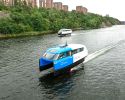Pre-study proposes new pilot training program

Sweden faces an acute shortage of maritime pilots, and action is needed to ensure the continuity of the profession. A new pre-study by Lighthouse explores how pilot training can be restructured to more quickly bring new pilots into service.
In 2019, Swedish media raised alarms about the shortage of pilots and the need for measures to address upcoming retirements. The situation has not improved since then. According to the study, Ny lotsutbildning (New Pilot Training), 35 of Sweden's approximately 200 pilots are expected to retire within the next three years, creating a recruitment need of around 20 pilots per year. Meeting this demand is no easy task. Not just anyone can become a pilot. The Swedish Maritime Administration (Sjöfartsverket) trains pilots internally, but applicants must meet stringent requirements, including holding a captain’s certificate (sjökaptensbrev) and having at least three years of effective sea service, which typically translates to six years of professional experience. Candidates must also pass an aptitude test at the Swedish Defence Recruitment Agency and a simulator test before being hired.
“There has been a declining trend in applications to maritime officer schools overall, which is a challenge for the entire shipping industry. This makes the pool of candidates quite limited,” says Maria Gripenblad, project manager at Sjöfartsverket and leader of the pre-study.
There is a clear need to find alternative pathways to becoming a pilot. Could a pilot training program engage maritime officers earlier in their careers, thereby increasing the number of candidates? Germany, for example, has introduced a master’s program specifically for pilots.
“We initially looked into whether something similar could be done in Sweden, but a master’s program here wouldn’t allow for as much practical training as we believe is necessary,” Gripenblad explains.
Instead, the study explored the possibility of establishing a new type of vocational degree. However, this would require changes to Sweden’s Higher Education Ordinance and would raise many other questions.
“There’s a lot to sort out. For instance, such a pilot training program would need to be longer than the one currently run by Sjöfartsverket. Should these new components also be managed by Sjöfartsverket, or by another entity? That’s why our conclusion is that we need to create a pilot program and evaluate it scientifically. What should the curriculum include? What pedagogical methods should be used?”
One major question is whether the current sea service requirement can be replaced with something else. The report suggests conducting more comprehensive aptitude tests before the training begins.
“Just because someone has spent 20 years aboard the same ship doesn’t necessarily mean they’re suitable to be a pilot. So, what personal traits and skills are critical? If we can identify these, the selection process becomes even more important when candidates lack extensive life experience. The next step is to investigate whether and how these traits can be tested,” Gripenblad says.
Limited sea service would also mean that pilot trainees would likely need more supervised trips than current candidates, placing greater demands on their mentors at sea. According to the report, simulators are useful in training but cannot entirely replace practical experience: “In addition to supervised trips and simulator time, training on school ships and scaled model boats could be ways to build knowledge and experience.”
Age and leadership present additional challenges. The age structure at sea is notable, with hierarchical values deeply ingrained. A young pilot can expect their experience and knowledge to be questioned. They must be prepared to manage their professional role in interactions with captains who are older, more experienced, and accustomed to being in charge.
“The best approach is to implement a test training program and address these issues step by step. Ideally, we can do this as part of a research project involving experts who have worked on similar challenges before. That’s where we stand now,” Gripenblad concludes.
The pre-study Ny lotsutbildning was authored by Andreas Arvidsson (Sjöfartsverket), Jonas Lundin (Sjöfartsverket), Lars Axvi (Sjöfartsverket), Maria Gripenblad (Sjöfartsverket), Fredrik Olindersson (Chalmers University of Technology), Reto Weber (Chalmers University of Technology), and Fredrik Hjorth (Linnaeus University).
-
 Ny studie: Eldrivna pendelbåtar kan effektivisera Stockholms kollektivtrafik
Ny studie: Eldrivna pendelbåtar kan effektivisera Stockholms kollektivtrafik -
 Sjöfartens utsläpp ökar
Sjöfartens utsläpp ökar -
 Sociala relationer påverkar val av bränsle
Sociala relationer påverkar val av bränsle -
 Sjöfartens omställning kräver ”mjukare” påtryckningar
Sjöfartens omställning kräver ”mjukare” påtryckningar -
 Hon hade avtalad tid med Kapten ynkrygg
Hon hade avtalad tid med Kapten ynkrygg -
 Lighthouse omvärldsanalys 2025 – osäkerhet och tullar präglar sjöfarten
Lighthouse omvärldsanalys 2025 – osäkerhet och tullar präglar sjöfarten -
 Se seminariet Shipping in the Marine Environment
Se seminariet Shipping in the Marine Environment -
 Vad betyder egentligen de 90 procenten?
Vad betyder egentligen de 90 procenten? -
 Hålla där...
Hålla där... -
 Ny rapport: Klimatförändringarna ett hot mot de flesta större hamnar i världen
Ny rapport: Klimatförändringarna ett hot mot de flesta större hamnar i världen

